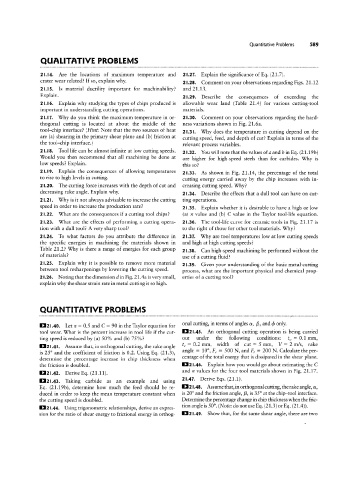Page 608 - 04. Subyek Engineering Materials - Manufacturing, Engineering and Technology SI 6th Edition - Serope Kalpakjian, Stephen Schmid (2009)
P. 608
Quantitative Problems 589
QUALITATIVE PROBLEMS
21.14. Are the locations of maximum temperature and 21.27. Explain the significance of Eq. (21.7).
crater wear related? If so, explain why. 21.28. Comment on your observations regarding Figs. 21.12
21.15. Is material ductility important for machinability? and 21.1 3.
Explain. 21.29. Describe the consequences of exceeding the
21.16. Explain why studying the types of chips produced is allowable wear land (Table 21.4) for various cutting-tool
important in understanding cutting operations. materials.
21.11. Why do you think the maximum temperature in or- 21.30. Comment on your observations regarding the hard-
thogonal cutting is located at about the middle of the ness variations shown in Fig. 21.6a.
tool-chip interface? (Hint: Note that the two sources of heat 21.31. Why does the temperature in cutting depend on the
are (a) shearing in the primary shear plane and (b) friction at cutting speed, feed, and depth of cut? Explain in terms of the
the tool-chip interface.) relevant process variables.
21.18. Tool life can be almost infinite at low cutting speeds. 21.32. You will note that the values ofa and [9 in Eq. (21.19b)
Would you then recommend that all machining be done at are higher for high-speed steels than for carbides. Why is
low speeds? Explain. this so?
21.19. Explain the consequences of allowing temperatures 21.33. As shown in Fig. 21.14, the percentage of the total
to rise to high levels in cutting.
cutting energy carried away by the chip increases with in-
21.20. The cutting force increases with the depth of cut and creasing cutting speed. Why?
decreasing rake angle. Explain why. 21.34. Describe the effects that a dull tool can have on cut-
21.21. Why is it not always advisable to increase the cutting ting operations.
speed in order to increase the production rate? 21.35. Explain whether it is desirable to have a high or low
21.22. What are the consequences if a cutting tool chips? (a) n value and (b) C value in the Taylor tool-life equation.
21.23. What are the effects of performing a cutting opera- 21.36. The tool-life curve for ceramic tools in Fig. 21.17 is
tion with a dull tool? A very sharp tool? to the right of those for other tool materials. Why?
21.24. To what factors do you attribute the difference in 21.37. Why are tool temperatures low at low cutting speeds
the specific energies in machining the materials shown in and high at high cutting speeds?
Table 21.2? Why is there a range of energies for each group 21.38. Can high-speed machining be performed without the
of materials? use of a cutting fluid?
21.25. Explain why it is possible to remove more material 21.39. Given your understanding of the basic metal-cutting
between tool resharpenings by lowering the cutting speed. process, what are the important physical and chemical prop-
21.26. Noting that the dimension din Fig. 21 .4a is very small, erties of a cutting tool?
explain why the shear strain rate in metal cutting is so high.
QUANTITATIVE PROBLEMS
u21.40. Let n = 0.5 and C = 90 in the Taylor equation for onal cutting, in terms of angles oz, ,B, and <19 only.
tool wear. What is the percent increase in tool life if the cut- u21.45. An orthogonal cutting operation is being carried
ting speed is reduced by (a) 50% and (b) 75%? out under the following conditions: to = 0.1 mm,
|]21.41. Assume that, in orthogonal cutting, the rake angle tc = 0.2 mm, width of cut = 5 mm, V = 2 m/s, rake
angle = 10°, FC = 500 N, and F, = 200 N. Calculate the per-
is 25° and the coefficient of friction is 0.2. Using Eq. (21.3),
centage ofthe total energy that is dissipated in the shear plane.
determine the percentage increase in chip thickness when
the friction is doubled. |]21.46. Explain how you would go about estimating the C
u21.42. Derive Eq. (21.11). and 71 values for the four tool materials shown in Fig. 21.17.
||2|.43. Taking carbide as an example and using 21.47. Derive Eqs. (21.1).
Eq. (21.19b), determine how much the feed should be re- |12 1.48. Assume that, in orthogonal cutting, the rake angle, oz,
duced in order to keep the mean temperature constant when is 20° and the friction angle, B, is 35° at the chip-tool interface.
the cutting speed is doubled. Determine the percentage change in chip thickness when the fric-
|12 1.44. Using trigonometric relationships, derive an expres- tion angle is 50°. (Note: do not use Eq. (21.3) or Eq. (21.4)).
sion for the ratio of shear energy to frictional energy in orthog- u21.49. Show that, for the same shear angle, there are two

